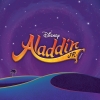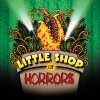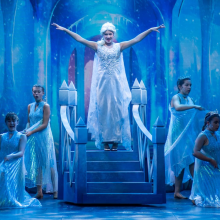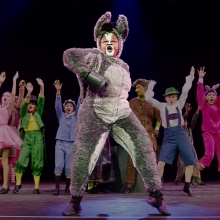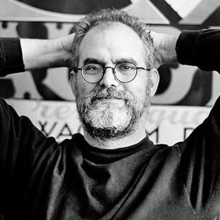"Tale as Old as Time": The Literary Origins of BEAUTY AND THE BEAST
"Tale as Old as Time": The Literary Origins of BEAUTY AND THE BEAST
By GERRY LIU on August 14, 2009
Over the centuries, the "tale as old as time" has seen multiple incarnations and adaptations. From fable to musical, the evolution of Beauty and the Beast is an extraordinary journey, rich in history. 
The motif of the beautiful maiden, forbidden to look upon her lover, is a universal literary occurrence. Folklorists have traced the origin of the story as far back as the second century C.E., to the Roman writer Apuleius. In his writings, Apuleius tells the story of Cupid and Psyche. Psyche weds a serpent that is really Cupid but under a spell. He comes to her by night, as a man, but she is forbidden to look at his face. When she does look, she loses him forever. This also echoes the Greek myth of Orpheus and Eurydice. When guiding Eurydice back from the underworld, Hades warns Orpheus not to look back at her, or he will never see her again.
Since then, multiple versions of the story have been re-written in various countries. 16th century Italian folklorist, Giovanni Francesco, told the story of Rico Porco (King Pig), a man who earns his name, not for being a beast, but for his "swinish" behavior toward women in general. One hundred years later, Italian writer Giambattista Basile wrote four more Beauty and the Beast type fairy tales. In 1697, Charles Perrault wrote a version of the tale, leaving the reader to wonder: Does the beast transform into a handsome man or does he appear to do so in the eyes of the young woman who loves him? Perhaps the most fascinating version of the story is a Norwegian interpretation, recorded by Hans Christian Anderson, titled "East of the Sun and West of the Moon." In this story, the "beast" is a white bear, but he is transformed into a man every night so that he may be with Beauty. As with the story of Psyche, Beauty is forbidden to look at her handsome lover. These varying versions are mirrors of the societies in which they were written, reflecting gender roles/stereotypes, repression, and morality.
In 1740, The French Madame Gabrielle-Suzanne Barbot de Gallon Villeneuve wrote a version of Beauty and the Beast, not as a means to entertain children or as an examination of society, but for the purposes of entertaining her salon friends. Villeneuve's tale includes the history of both Belle and the Beast. The Beast, a young, fatherless Prince, is left in the care of an evil fairy who tries to seduce him when he has reached adulthood. When he rejects her, she turns him into a beast. Belle's history reveals that she is the offspring of a King and the same evil fairy that tried to seduce the Beast. The fairy tries to murder Belle so that she may have the King to herself. The King gives Belle to a merchant man in hopes of concealing her identity and saving her life.
In 1756, the French Aristocrat, Madame Jeanne-Marie Le Prince de Beaumont, emigrated to England, becoming a tutor and an author. She shortened Villeneuve's version, leaving out the back story of Belle and the Beast and ended it with the Beast's transformation. Beaumont's version is widely known today and is the basis for Disney's Beauty and the Beast animated classic and stage adaptation.
To license BEAUTY AND THE BEAST or to learn more, click here
To license BEAUTY AND THE BEAST JUNIOR or to learn more, click here
To "click" with other BEAUTY AND THE BEAST FANS, visit www.mtishowspace.com

The motif of the beautiful maiden, forbidden to look upon her lover, is a universal literary occurrence. Folklorists have traced the origin of the story as far back as the second century C.E., to the Roman writer Apuleius. In his writings, Apuleius tells the story of Cupid and Psyche. Psyche weds a serpent that is really Cupid but under a spell. He comes to her by night, as a man, but she is forbidden to look at his face. When she does look, she loses him forever. This also echoes the Greek myth of Orpheus and Eurydice. When guiding Eurydice back from the underworld, Hades warns Orpheus not to look back at her, or he will never see her again.
Since then, multiple versions of the story have been re-written in various countries. 16th century Italian folklorist, Giovanni Francesco, told the story of Rico Porco (King Pig), a man who earns his name, not for being a beast, but for his "swinish" behavior toward women in general. One hundred years later, Italian writer Giambattista Basile wrote four more Beauty and the Beast type fairy tales. In 1697, Charles Perrault wrote a version of the tale, leaving the reader to wonder: Does the beast transform into a handsome man or does he appear to do so in the eyes of the young woman who loves him? Perhaps the most fascinating version of the story is a Norwegian interpretation, recorded by Hans Christian Anderson, titled "East of the Sun and West of the Moon." In this story, the "beast" is a white bear, but he is transformed into a man every night so that he may be with Beauty. As with the story of Psyche, Beauty is forbidden to look at her handsome lover. These varying versions are mirrors of the societies in which they were written, reflecting gender roles/stereotypes, repression, and morality.
In 1740, The French Madame Gabrielle-Suzanne Barbot de Gallon Villeneuve wrote a version of Beauty and the Beast, not as a means to entertain children or as an examination of society, but for the purposes of entertaining her salon friends. Villeneuve's tale includes the history of both Belle and the Beast. The Beast, a young, fatherless Prince, is left in the care of an evil fairy who tries to seduce him when he has reached adulthood. When he rejects her, she turns him into a beast. Belle's history reveals that she is the offspring of a King and the same evil fairy that tried to seduce the Beast. The fairy tries to murder Belle so that she may have the King to herself. The King gives Belle to a merchant man in hopes of concealing her identity and saving her life.
In 1756, the French Aristocrat, Madame Jeanne-Marie Le Prince de Beaumont, emigrated to England, becoming a tutor and an author. She shortened Villeneuve's version, leaving out the back story of Belle and the Beast and ended it with the Beast's transformation. Beaumont's version is widely known today and is the basis for Disney's Beauty and the Beast animated classic and stage adaptation.
To license BEAUTY AND THE BEAST or to learn more, click here
To license BEAUTY AND THE BEAST JUNIOR or to learn more, click here
To "click" with other BEAUTY AND THE BEAST FANS, visit www.mtishowspace.com



